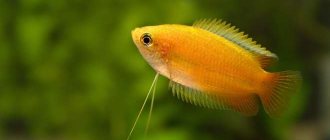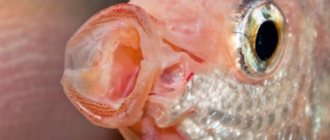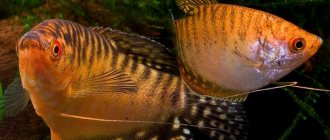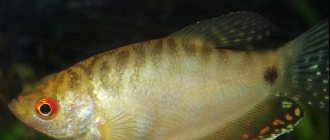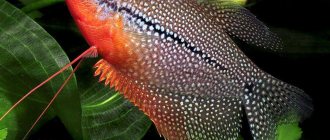Striped gourami (Trichogaster fasciata) Bloch et Schneider, 1801.
It was officially described in 1801 by Markus Eliezer Bloch and Johann Gottlob Schneider.
It is the largest gourami of its kind and has a labyrinth through which it receives atmospheric air. It is distinguished by a variety of colors, body sizes and head shapes, which is associated with the vast territories that it inhabits in nature.
Synonyms
Russian: Striped colisa, Ribbon gourami Latin: Colisa fasciata (Bloch & Schneider, 1801), Colisa fasciatus (Bloch & Schneider, 1801) Polyacanthus fasciatus (Bloch & Schneider, 1801), Trichopodus colisa (Hamilton, 1822), Trichopodus bejeus (Hamilton , 1822), Trichopodus cotra (Hamilton, 1822), Colisa vulgaris (Cuvier, 1831), Colisa ponticeriana (Valenciennes, 1831)
Order: Crawler-like (Anabantiformes) Family: Macropods or Guramis (Osphronemidae) Genus: Trichogaster or Gourami-threaders (Trichogaster)
Range and Habitat
Asia: India, Nepal, Bangladesh, upper Myanmar, China and Pakistan.
They mainly live in the Brahmaputra and Ganges rivers, their lower and middle reaches, as well as the Irrawaddy River. They are also found in other mostly slow-flowing rivers, as well as canals, ponds, lakes, rice fields, and less often in coastal salt waters.
Description
The body is oval, slightly elongated in shape, resembling an ellipse and slightly flattened on the sides. Mouth with thick lips, the upper part of which protrudes forward and is more pronounced in the male. The older you are, the thicker your upper lip.
Colisa cf. fasciata from Manipur, India
The thread-like pelvic fins are elongated and contain the organs of taste and touch. The bases of the dorsal and anal fins are elongated, with a border along the edge.
Colias (C. fasciata) mouth with thick lips, close-up
The color is greenish with oblique orange or bluish stripes running down and back from the back to the anal fin. On the sides there are oblique stripes of turquoise color. The chest, abdomen and gills are green-blue. The back and head are dark. The anal fin has red spots, like the caudal one, and the dorsal fin is yellowish-white. The color of females is brown, sometimes with yellowish tint. Along the sides there are the same stripes as in males; another stripe, longitudinal and interrupted, stretches along the entire body. There are individuals of gray-green and light purple color. Below on the gill cover there is a turquoise shiny spot.
The body shape of the fish and its color depend on the region in which it was caught.
Size:
The maximum standard length of a male can reach 10 cm, females are usually slightly smaller.
Behavior and Compatibility
They feel comfortable in numbers of 6-10 individuals; females should predominate in the group.
Colisa fasciata (Colisa fasciata) sparring males
Suitable for most peaceful aquarium communities, but can be a little aggressive during the spawning season. Males will fight each other in small tanks. Keep them with harmless species that don't look much like him. Good neighbors will be schools of rasboras, danios and barbs, as well as loaches and smaller orca catfish. In a larger aquarium, you could keep it as part of a community of gourami species. However, thick-lipped gourami Colisa labiosa should be avoided as the two species can interbreed.
Gourami species
Colises (lat. Colisa) is a genus of labyrinthine fish from the family of macropods (Osphronemidae). There are several types of them, we list some of them:
- dwarf, lalius
- honey
- red neon
- samurai
- blue
- chocolate
Other species not listed in the photo:
|
|
Aquarium
The size of the aquarium is about 75 * 30 cm - from 70 liters is large enough for a couple. For a group you will need an aquarium of at least 150 liters, always with a lid that protects the air near the surface from cooling.
Colisa fasciata aquarium biotope, Asia
Plants are planted around the perimeter of the aquarium, and the free space left for swimming must be shaded with floating plants, such as richia or salvinia. Dense thickets are created with the help of long-stemmed plants with dissected leaves - hygrophiles, limnophiles.
Colisa fasciata female in an aquarium
Quite shy and need shelter from snags, stones and plants. Easily adapts to life in an aquarium.
Colisa fasciata male in an aquarium
Water parameters:
Temperature: 22 - 28° C pH: 6.0 - 7.5 Hardness: 5 - 15° dGH
Filtration and aeration are not necessary, but they prefer clean water and installation of equipment is still necessary. Keep water movement to a minimum. Water changes are carried out weekly by 1/4.
Compatibility with other aquarium fish
As mentioned above, lalius are peaceful and fearful roars. In communal aquariums, no one is ever touched. Small peaceful fish will suit them as neighbors: platies, corydoras catfish, otocinclus, guppies. Lalius do not like fuss, so it is better not to put fast and active fish such as zebrafish with them.
Fish are characterized by intraspecific aggression. If there are several males in a small aquarium, they will fight. In addition, the male can chase the female. To prevent it from dying, the bank must have shelters - dense thickets, snags with growing moss or anubias.
Sexual Dimorphism
Typically, males are slightly larger in size than females. Males are much more colorful and when they reach maturity they develop pointed dorsal and anal fins, while females have more rounded fins.
Striped coliza (C. fasciata) male, appearance, difference
Colisea striped (C. fasciata) female, appearance, difference
They become sexually mature at the age of 1 year, with the total length of the male and female reaching approximately 10 cm and 6-8 cm, respectively.
Breeding
For reproduction you will need a spawning tank measuring 30*60 cm, filled with 10-15 cm of water. The temperature gradually rises by several degrees, and the acidity level is brought to 4-7 by adding 1/3 of distilled water. Soil is not required.
Add plenty of floating plants, as well as some small-leaved plants, to provide cover for the female. Water movement should be avoided. Either use a sponge air filter bubbling gently in the corner, or don't use it at all. Other parameters are not critical if they are within the limits suggested above. The aquarium should have a tight-fitting lid (some breeders use adhesive film instead to avoid gaps) as the fry need to have access to a layer of warm, moist air. Without this, the development of the labyrinthine organ may be impaired.
The breeders are kept in different aquariums a week before spawning. Spawning can be in pairs, but in this case there is a risk that the male will kill a female that is not ready for spawning. To avoid this and for effective spawning, several females with one male are placed in the aquarium, which allows his attention to be dispersed.
Striped colisa (Colisa fasciata) nest from the air
The male builds a foam nest only in twilight, so the spawning area is shaded. The female lays up to 1000 eggs in portions, then settles. The male, caring for the offspring, adds air bubbles to the nest and returns the fallen eggs to their place.
Incubation lasts 24-36 hours. After 3-5 days, the juveniles disperse in search of food: ciliates and rotifers.
At this stage, the male is also removed and the water level is reduced. As the fish grow, the amount of water in the spawning tank increases.
Due to uneven growth, the fry need to be sorted, which prevents cannibalism. At 2 months of age, the fry, which have leveled off in growth, can be released into one aquarium.
When favorable conditions are created, the life expectancy in an aquarium is about 5 years.
Striped colisa
The striped coliza is a very beautiful fish, having a color similar to the color of the lalius, but its size is much larger. Therefore, the impression it makes is much greater. The species was first described in 1801 by Bloch and Schneider. European aquarists recognized this fish in 1897. It first appeared in Russia in 1904. Domain: Eukaryotes Kingdom: Animals Phylum: Chordata Class: Ray-finned fishes Order: Perciformes Family: Macropods Genus: Colises Species: Striped coliza (Colisa fasciata) The homeland of the striped coliza is Thailand, Malaysia, Burma, India. Its dimensions, as already mentioned, are larger than other representatives of the genus. In the wild, it reaches twelve centimeters in length. [sam_ad id=»15" codes=»true"] Behind the glass of the aquarium it can reach ten centimeters. The body is laterally flattened, relatively high. Its body is decorated with alternating transverse stripes of blue and orange. The main tone of the body is blue. Unpaired fins have red speckling and blue edging. In males, the dorsal fin is pointed at the back, in females it is rounded. The pelvic fins are modified into whiskers. Keeping the striped coliza is not difficult. For a couple of adult fish, an aquarium with a volume of about 30 liters is sufficient. The soil can be almost any of the long-established ones. Suitable coarse river sand, small pebbles, fine gravel. It is also possible to use decorative soils. Any vegetation with suitable maintenance conditions. It is advisable to organize small thickets of them near the side and rear windows. You can use hornwort, vallisneria, elodea ferns for landscaping an aquarium with striped colizas , cryptocorynes. The lighting is preferably bright. It is necessary that the aquarium is illuminated by sunlight for several hours a day. But you should not place an aquarium on the windowsill. Since this place is subject to the greatest temperature fluctuations, and the fish do not like this. The water should have a temperature of about 26 degrees Celsius. Hardness is not particularly important; acidity should be neutral. In general, you can take ordinary water from the tap, let it sit for a day to free it from chlorine, heat it to the desired temperature, and that’s it. No other water treatment is required. It is advisable to cover the top of the aquarium with glass. The striped colisa is a labyrinthine fish and uses atmospheric air to breathe, so it is not advisable for cold air to accumulate above the surface of the water. Swallowing it can make your fish sick. The glass that covers the aquarium prevents the rapid entry of cold air into the surface space. You can feed the striped cattail with any food. But preference should be given to live food of suitable sizes. Their most favorite foods in our latitudes can be small artemia, daphnia, small bloodworms, chopped tubifex and even finely uncut earthworms. Especially good living conditions must be created for fish if you want to get offspring from them. Future producers should try to feed exclusively live, varied foods. At the same time, you should remember the dangers of inbreeding, and if you decide to start breeding these beautiful fish, you should try to take females from one fishery and males from another. The fact is that striped coliza was brought to Russia more than once. But, unfortunately, its magnificent coloring is lost after several generations in our aquariums. Why is this happening? It is difficult to give a definite answer. Most likely, this is a combination of several factors. Poor nutrition and inbreeding can also accelerate the degeneration of a species, and in the case of representatives of the genus Coliza, a lack of solar insolation is also possible. Maybe you can answer these questions
